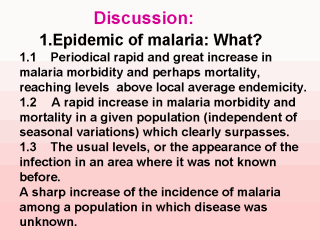Search inside of Supercourse and lectures in HTML and PPT format
 |
 |
front |1 |2 |3 |4 |5 |6 |7 |8 |9 |10 |11 |12 |13 |14 |15 |16 |17 |18 |19 |20 |21 |22 |23 |24 |25 |26 |27 |28 |29 |30 |review |
 2. Seasonal indices (SI): As SI > 1 presumes transmission season, the malaria transmission season in the study area generally peaks in the early part of the year and latter part of the year for the period 1984 to 1992. The highest SI was observed in the last quarter during the study periods. This suggests that an explosive epidemic occurrence in the 4th quarter of 1990 was the resultant of malaria transmission started in the first 3 months of 1990. It then become prolonged and covered the first 3 months in 1991 according to the present finding. Yet, perennial transmission of malaria was not evident in 1984-92, according to our findings. |